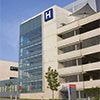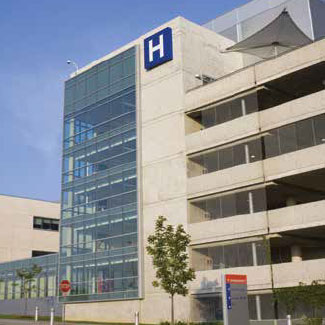
Maintaining Good Health
Technology systems, including IP video, promote security that is essential to healing
- By Courtney Mamuscia
- Jul 01, 2014
 Hospitals offer patients a controlled environment
that encourages rapid healing protected
from the outside world. Yet, hospitals are open
to the public and subject to many of the same
security threats as the world at large. Hospital
campuses are almost like micro-cities, housing
numerous buildings and parking garages
that are visited by hundreds, even thousands of
people every day.
Hospitals offer patients a controlled environment
that encourages rapid healing protected
from the outside world. Yet, hospitals are open
to the public and subject to many of the same
security threats as the world at large. Hospital
campuses are almost like micro-cities, housing
numerous buildings and parking garages
that are visited by hundreds, even thousands of
people every day.
Because there is access 24-hours-a-day and a continuous flow of
people coming and going, hospitals can have drama, too. The stress of
family issues—whether stemming from custody disagreements about
newborn infants or domestic violence that erupts in an emergency
room—can threaten the safety and security hospitals depend on to
function as intended. Patients, visitors and staff must be protected
from the all-too-common violent outbursts that happen every day in
society which can spill over into the healthcare setting.
Further complicating issues, hospitals have large stocks of drugs
that must be secured.
In addition, healthcare facilities are large repositories of private
patient information that, by law, must be protected. Compliance with
the requirements of the Health Insurance Portability and Accountability
Act (HIPAA) includes a need for physical security measures to promote
privacy of patient information.
Taken together, these requirements challenge the best capabilities
security technology has to offer. Hospitals protect their facilities using a
range of systems from video surveillance, alarms and access control to
weapons screening, voice communication and asset management. Fortunately,
new capabilities of IP video and information networks are expanding
the security industry’s ability to provide protection to hospitals.
Statistics Highlight Security Challenges
The International Association for Healthcare Security and Safety
(IAHSS) estimates that 98 percent of healthcare facilities experience
violence and crime. In its 2012 Crime and Security Trends Study,
IAHSS reported a total of 20,515 crimes among the 208 member
healthcare organizations surveyed, showing increases of almost 37
percent since the previous survey just two years before. Crimes at
healthcare facilities had increased in almost every category including
simple assaults, larceny, thefts, vandalism, rape and sexual assaults.
There were eight homicides reported among these surveyed organizations,
the highest number ever reported in this survey.
The statistics point clearly to a need for greater vigilance when
watching over people, facilities and assets on hospital premises. Video
surveillance has long been a tool to enable hospitals to monitor their
vast network of buildings, campuses and parking structures; however,
some hospital surveillance systems are still using outdated analog systems
that may not fully address the changing surveillance needs of
hospitals. It’s time to upgrade and, for many, the need is critical for
systems that perform better.
Regulatory Aspects of Hospital Security
Regulatory requirements promote the need for greater security in the
hospital environment. One of the main organizations leading the way,
as hospitals seek to provide the safest, highest-quality and best-value
services, is The Joint Commission, a non-profit organization that certifies
healthcare organizations across the United States based on each
hospital’s commitment to performance and standards.
When certifying and overseeing healthcare institutions, the Joint
Commission categorizes security breaches that could lead to accidental
death or other significant impacts like “sentinel events.” Each hospital
must perform a root cause analysis and implement preventive
measures, including security. If a hospital doesn’t respond, it could be
put on “accreditation watch,” which could put a hospital’s reputation at
risk. In a real way, therefore, effective security is a basic requirement
for hospitals to continue operating.
Protecting stored patient data is another regulatory requirement,
this one mandated by HIPAA. Patient information may be contained
in written form, such as patient charts that hospitals have used for
many years, and is also increasingly stored electronically. Whether the
data is in a file cabinet or on a computer server, it must be safeguarded.
Other entities mandate that hospitals ensure a safe setting for
patients, visitors and employees, including regulations by OSHA, the
Centers for Disease Control and Prevention (CDC) and NFPA.
Better Security Using Video Surveillance
As a component of overall hospital security, video surveillance has
performed dependably and effectively for many years. Even analog
images of what happens in various parts of a hospital can provide useful information; however, the emergence of IP video systems—and
acceleration in the number of hospitals that use the systems—has
greatly expanded the positive impact of video on hospital operations.
Deploying a robust, integrated and reliable IP video management
solution offers remarkable advantages in promoting the safety and
security of patients, employees and visitors. IP video provides clearer
views of a hospital’s expansive infrastructure including psychiatric
wards, parking garages, delivery docks, onsite pharmacies and the
emergency department. And, higher-resolution IP cameras can quickly
identify potentially dangerous situations so these events can be
addressed without disturbing ongoing operations within the hospital.
One tool to manage higher-resolution video more effectively is
video analytics, which can typically “watch” a specific scene and is
programmed to alarm if something happens. The alarm could be based
on motion in an area that is usually deserted or based on someone
crossing a “virtual line” into a prohibited area. The use of video analytics
to trigger video recording only when there is something to see
enables less video to pass across the network. Other analytics can monitor
scenes for changes in specific behavior that is outside the norm for
a specific scene. This could be helpful in generating live alerts for security
and could send video of the scene in question to security monitors.
To be effective, video systems need to both capture clear, high-quality
images and provide them when and where they are needed. Video
management software (VMS) must provide both live views and easy
access to stored video. Access of video on mobile devices enables security
personnel to be more productive and available to respond. If a
violent incident is under way in the emergency room, security personnel
need immediate access to video as the event unfolds. Likewise, if
something was stolen from the pharmacy after hours, it should be easy
to search through stored video to identify exactly what happened as
well as when and who was involved. It should also be easy to save the
video to be shared with law enforcement or used in a court of law.
Newer VMS solutions are easy to use and have advanced search
capabilities to enable an operator fast and dependable access to needed
video. It’s also easier to integrate video systems with other systems,
such as intrusion detection and access control.
Safety Promotes Healing
Changes in how healthcare is being delivered are impacting the larger
issue of healthcare security. New healthcare alternatives are surfacing
as a result of the Affordable Care Act (ACA), and new medical complexes
and smaller urgent care facilities are now part of the bigger
picture. The broader healthcare community also includes educational
campuses that teach medical practices to future doctors and nurses.
Various institutions have many common security concerns, but each
poses unique challenges.
As the U.S. healthcare market is currently undergoing fundamental
adjustments, insurance reform and rising costs are changing many
aspects of how hospitals operate. What must not change, however, is
the devotion of resources and personnel to ensure safety of hospital
facilities, assets and especially people.
Hospitals may be open to the public and subject to many of the same
security threats as the world at large, but strategic
use of technology can keep those threats from disrupting
the environment essential to fulfill each
hospital’s healing mission.
This article originally appeared in the July 2014 issue of Security Today.